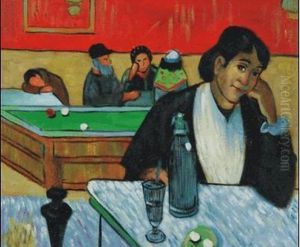T. Gauguin Paintings
Eugène Henri Paul Gauguin, known as Paul Gauguin, was a French post-Impressionist artist who was not well appreciated until after his death. Gauguin was born on June 7, 1848, in Paris, France, but spent the early years of his childhood in Lima, Peru, which influenced his later work. He returned to France as a teenager and began a career as a stockbroker. It wasn't until his mid-30s that he began to pursue painting full-time, after initial dabbling as a Sunday painter.
Gauguin's early work was in the Impressionist style, and he exhibited with the Impressionists in 1876. However, he grew dissatisfied with the movement's limitations and began to explore different styles and techniques. He sought to break away from the naturalistic depictions of color and light that characterized Impressionism, aiming for a more synthesized approach to form and color. Gauguin developed a style that was known as 'Synthetism', characterized by the use of broad, flat areas of color and bold outlines, which was influential in the Symbolist movement.
In 1886, Gauguin spent a short but influential period in Pont-Aven in Brittany, where he became a leading figure of the Symbolist art movement. His search for a 'primitive' expression led him to Tahiti in 1891, where he hoped to escape European civilization and 'everything that is artificial and conventional'. There, he developed his distinctive style of depicting Tahitian life and landscapes, which incorporated the lush colors, bold lines, and simplified forms that became his trademarks.
Some of Gauguin's most famous works were created during his time in Tahiti, including 'Spirit of the Dead Watching' and 'Where Do We Come From? What Are We? Where Are We Going?'. His work during this period reflects a complex blend of the exotic and mystical, with hints of spiritual and philosophical inquiry.
Gauguin's personal life was tumultuous; he had strained relationships with his family and often faced financial difficulties. His health deteriorated in the tropics, and he struggled with conflicts with the colonial authorities. He died on May 8, 1903, in Atuona, in the Marquesas Islands, without having achieved the fame or financial success he had sought during his lifetime. It was only posthumously that his art gained recognition, influencing artists like Pablo Picasso and Henri Matisse and contributing to the rise of movements like Primitivism and Fauvism. Gauguin's bold experimentation with coloring, his cloisonnist style (a technique characterized by bold and flat forms separated by dark contours), and his exploration of non-Western aesthetics made him an important figure in the transition from the Impressionist to the modernist era in art.








